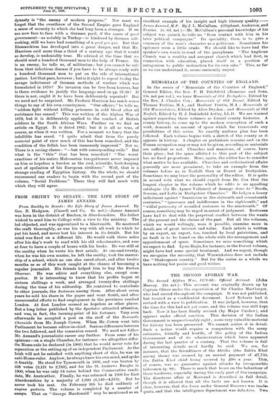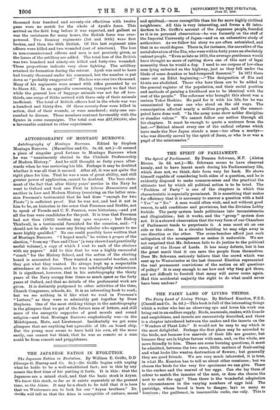THE SECOND AFGHAN WAR.
The Second Afghan War, 1878-80: Official Account. (John Murray. 21s. net.)—This account was originally drawn up by Captain Oliver under the supervision of Sir Charles MacGregor, who had served throughout the campaign. It was not published, but treated as a confidential document. Lord Roberts had it revised with a view to publication. It was judged, however, that the time for this had not yet come, and the volume was still kept back. Now it has been finally revised (by Major Cardew), and appears under official sanction. This decision of the Indian Government is unquestionably might; some very valuable material for history has been preserved. We cannot notice it in detail. Such a notice would require a comparison with the many estimates, friendly and hostile, of the policy of the Indian Government and of its administration which have appeared during the last quarter of a century. That the volume is full of interesting details need hardly be said. We see, for instance, that the friendliness of the Afridis (the Zakka Khel among them) was secured by an annual payment of • £7,750, the Zakka Kiel chief being secured by .e90 a year. This, of course, was no guarantee against attacks by irresponsible tribesmen (p. 89). There is much that bears on the behaviour of those borderers, especially during the early part of the campaign. The disastrous affair at Maiwand is described in full detail, though it is allowed that all the facts are not known. It is clear, however, that the force under General Burrows was inade- quate, and that the intelligence department was defective. Two thousand four hundred and seventy-six effectives with twelve guns were no match for the whole of Ayub's force. This arrived on the field long before it was expected, and gallant as VMS the resistance for many hours, the British force was over- powered. Two Bombay regiments (1st and 30th) were first 'broken, and then the 66th British. Of this last regiment nine officers were killed and two wounded (out of nineteen). The loss in non-commissioned officers and men is not precisely given, as the losses of the artillery are added. The total loss of the British Was two hundred and ninety-six killed and forty-two wounded. These proportions indicate very close fighting. The artillery retained its formation during the retreat. Aynb was said to have had twenty thousand under his command, but the number is put down as "probably exaggerated." His loss was over two thousand. Many of his regiments were armed With rifles presented by us to Shere AIL In an appendix concerning transport we find that while the general loss of baggage animals was not far off two- thirds, one corps of Sikhs arrived with three only of their animals inefficient. The total of British officers lost in the whole war was a-hundred and thirty-five. Of these seventy-four were killed in action, died of their wounds, or were murdered ; sixty-one suc- cumbed to disease. These numbers contrast favourably with the figures in some campaigns. The total cost was .217,500,000, also - a favourable contrast to other experiences.























































 Previous page
Previous page